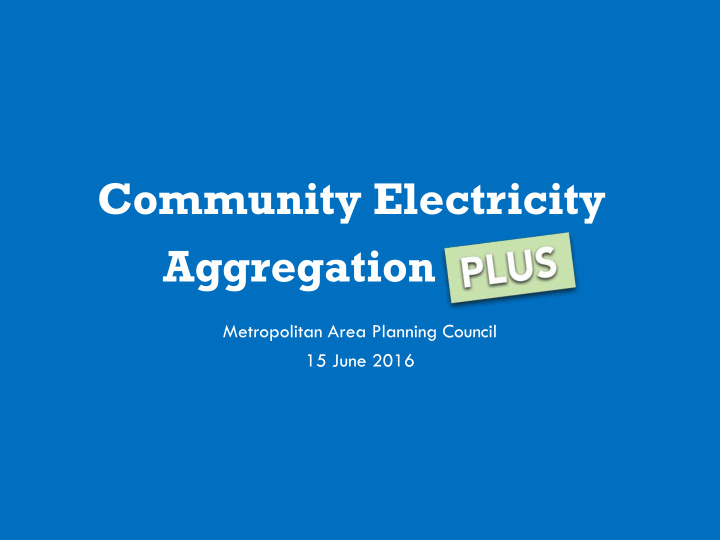



Community Electricity Aggregation Metropolitan Area Planning Council 15 June 2016
MAPC Clean Energy ▶ 101 cities and towns ▶ 80+ employees ▶ Wide range of planning services
Aggregation Consultant: Regional Procurement Fall 2015: MAPC issued RFP for green municipal aggregation broker - Done on behalf of entire MAPC membership - Named 4 communities in RFP - C. 30B process
Selection Committee + MAPC
Aggregation Consultant: Regional Procurement - The 3 consultants active in the state responded - Winner:
Aggregation Consultant: Regional Procurement - MAPC signed agreement with Good Energy - Ensures equal, fair treatment - Reporting to MAPC - MAPC municipalities subscribe to that agreement via 1-page form - Each municipality then signs its own agreement with Good Energy
Subscription Process - Commitment to green aggregation - MAPC fee - 1 st year of program ONLY - Covers MAPC time to organize procurement and administer program - Roughly 17 cents per household per year
Green Aggregation - Lots of definitions of “ green ” - Our definition: add renewable energy to the New England grid and thereby reduce emissions - There has to be evidence that your actions are having an impact!
Green Solution: MA Class I RECs • Comes from new renewable energy sources located on the Northeast grid • Revenue from the sale of MA Class I RECs are necessary to finance a project in this region • Generally not the case for: • Texas wind projects • Existing (“old”) New England renewables, like hydro
How Much? 5% MA Class I RECs in Default Rate Minimum MA Class I % in all electricity 11% supplies in the state. Increases 1% annually. Total MA Class I % in electricity supply of 16% participating MAPC communities
Why 5%? MA Class I RECs cost significantly more • than other types of RECs Cost reflects the • • Higher cost of development in the region and • The necessity of MA Class I RECs for project financing
Why 5% in the Default Rate? Your buying power is in the default rate - evidence has shown that almost everyone stays with the default rate Melrose & Dedham 4-9% of accounts opt-out of program completely • Of those that stayed in the aggregation • • 99% stayed on the default “5% extra green” product • <1% chose an optional “100% green” product • <1% chose an optional “no green” product
In Conclusion At 5% extra MA Class I RECs in the default rate, the Aggregation Achieves a massive purchase of RECs that, if • maintained, is highly likely to add new generation to the Northeast grid Has a minor impact on individual bills, so it maintains • financial benefits of aggregation
Community Electricity Aggregation Thanks!
Recommend
More recommend